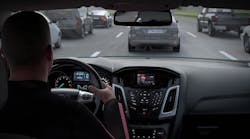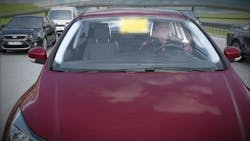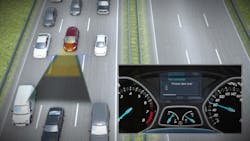As we all know, cars and trucks are increasingly being packed with all sorts of electronic systems designed to vastly improve their safety profile: electronic stability control, blind spot detection systems, heck even automatic braking technology to prevent collisions.
Now, however, Ford Motor Co. is trying to take things a step further – crafting a technological package to determine “workload stress” upon the driver, then re-adjusting the amount and levels of information being sent to driver in order to create a more “calming” operating environment.Whoa! Sounds like a vehicle acting like a psychiatrist to me!
The heart of this system is based on biometric feedback obtained via sensors in the steering wheel, seat and seat belt to provide a more complete model of driver stress levels, according to Jeff Greenberg, senior technical leader at Ford’s research and innovation division.
“Vehicle control inputs, sensors, road conditions and biometric information such as a driver's pulse and breathing can all be used to create a driver workload estimation that can then help manage certain functions in demanding situations,” he explained.
Greenberg pointed out that data from the sensing systems within a host of driver-assist technologies can be used to determine the amount of external demand and workload upon a driver at any given time including traffic and road conditions.
In addition, there’s a “health and wellness” side to this via ongoing research regarding the development of a biometric seat, seat belt and steering wheel that can monitor the condition of the driver to provide even more specific data concerning a driver’s “state of being.”
To accurately determine when “driver stress” exceeds safety norms, Greenberg said his team uses what’s called a “driver workload estimator” algorithm using real-time data from existing sensors such as radar and cameras combined with input from the driver's use of the throttle, brakes and steering wheel. The result is an intelligent system enabling management of in-vehicle communications based on the assessed workload of the driving situation, he explained.
[At this rate, cars will be able to provide yoga lessons and discourse upon the ‘Wheel of Dharma.’]For example, Greenberg said the side-looking radar sensors used within Ford’s Blind Spot Information System (BLIS) and the forward-looking camera for the Lane-Keeping System are on watch even when there is no active warning provided to the driver. These signals could indicate there is a significant amount of traffic in the lane a driver is merging into as he or she enters a highway.
Combine that knowledge with the fact that the driver has increased throttle pedal pressure to speed up, and the workload estimate could be high enough to determine it isn't a very good time for an incoming phone call to ring inside the cabin, he pointed out.
Thus, the car could intelligently apply the "Do Not Disturb" feature that is already available as part of MyFord Touch package, helping the driver stay focused on the road during the high-demand situation.
"In addition to using existing vehicle data to estimate demand on the driver, we're researching ways to get an even better understanding of the stress level of the driver," added Gary Strumolo, Ford’s manager of vehicle design and infotronics. "Biometric or health information of the driver can help us better tailor the experience when behind the wheel."
Turning new biometric sensors toward the driver will help to create a more complete picture of the driver workload, he explained. Ford’s research team has built a biometric seating buck to test a number of different sensors and gather data on how drivers respond to a variety of inputs for a driver behavior model, he said.
The experimental system adds several sensors to the steering wheel rim and spokes to get more detailed driver information. “Anyone who has used modern exercise equipment like treadmills and stair climbers will be familiar with the metal pads on the rim that can be used to measure the driver's heart rate,” Strumolo noted.Infrared sensors on the steering wheel monitor the palms of a driver's hands as well as his or her face looking for changes in temperature, while a downward-looking infrared sensor under the steering column measures the cabin temperature to provide a baseline for comparing changes in the driver's temperature. The final sensor is embedded in the seat belt to assess the driver's breathing rate, he said.
“With a more complete picture of the driver's health and wellness blended with knowledge of what is happening outside the vehicle, the car will have the intelligence to dynamically adjust the alerts provided to the driver and filter interruptions,” Strumolo said. “With the driver occupied in heavy traffic, the vehicle control system could increase the warning times for forward collision alerts and automatically filter out phone calls and messages, allowing the driver more time to respond. On the other hand, an alert driver on an open highway could receive incoming calls.”
Now, while all of those features are still in the research phase, he pointed out that they show significant opportunity to leverage data already being captured by the vehicle and then apply it in an “intelligent decision-making system” to simplify the driving experience.
Sounds more than a bit funky, but if such technology could indeed modulate the interior environment of a motor vehicle in tough situations – blocking calls, turning down the radio, and minimizing all but the most critical information flow – it just indeed might help make driving a less stressful occupation. That’s a lot of “ifs” of course, but it’ll be neat to see if Ford and others can make it work.






